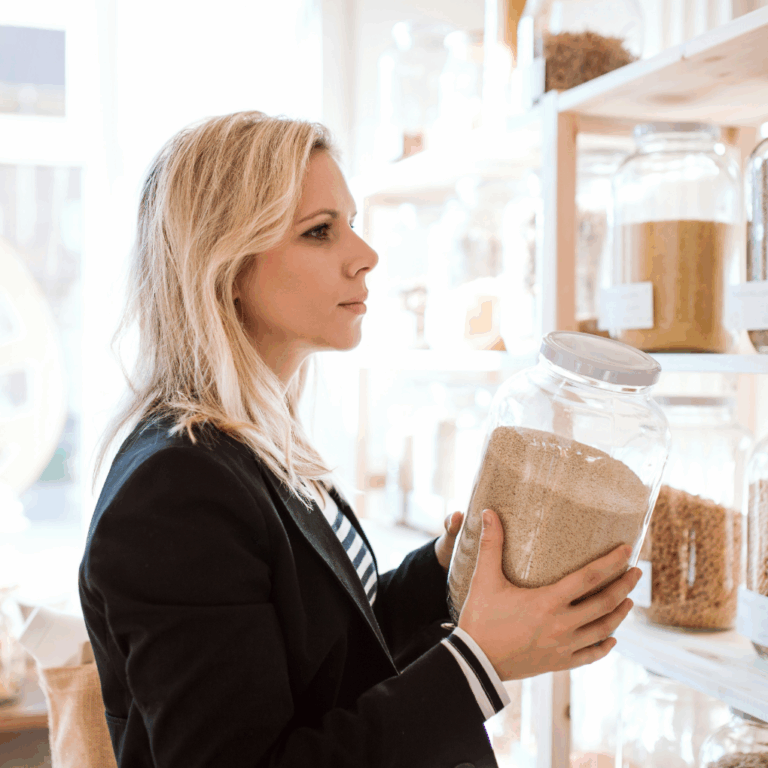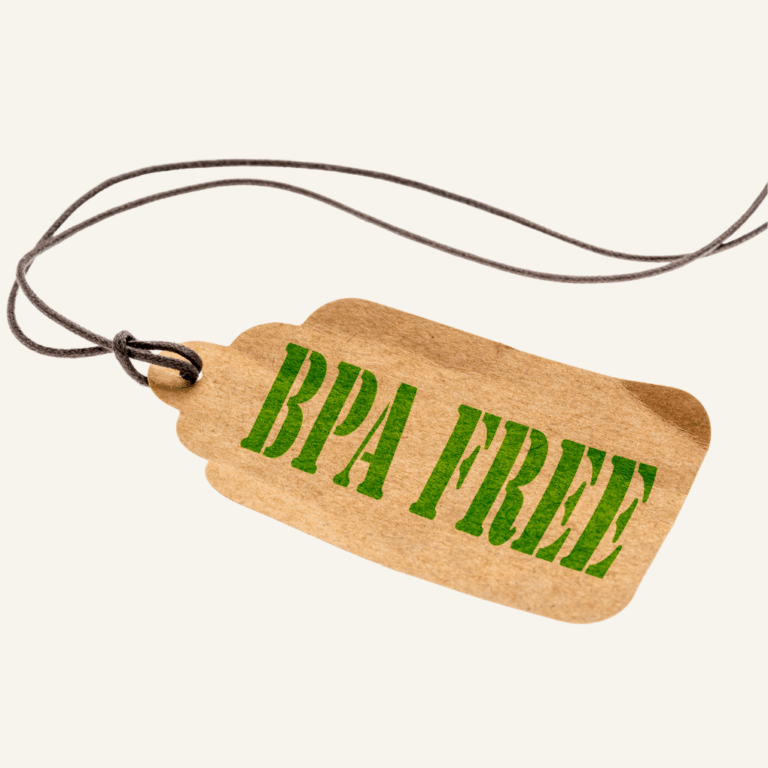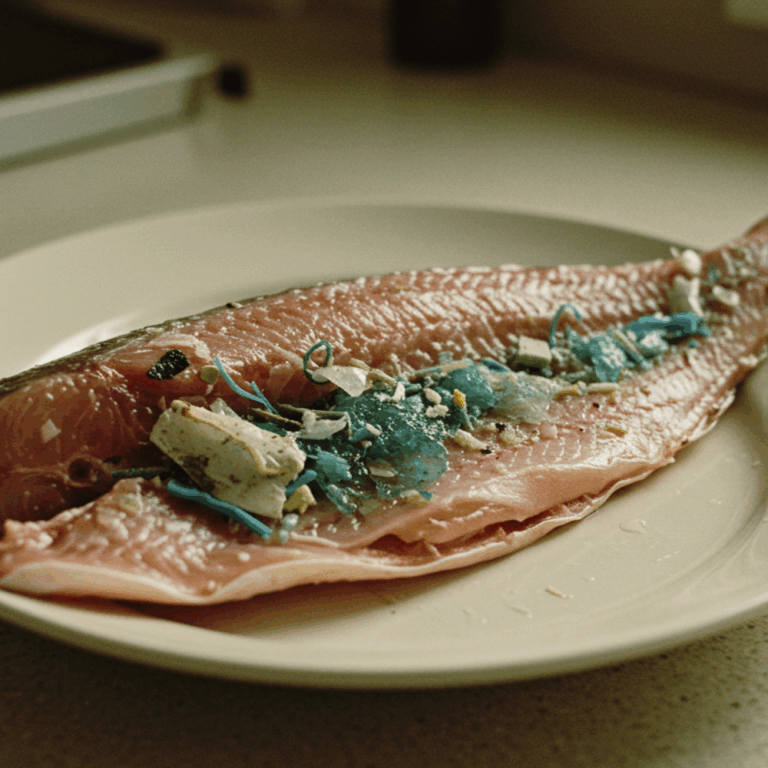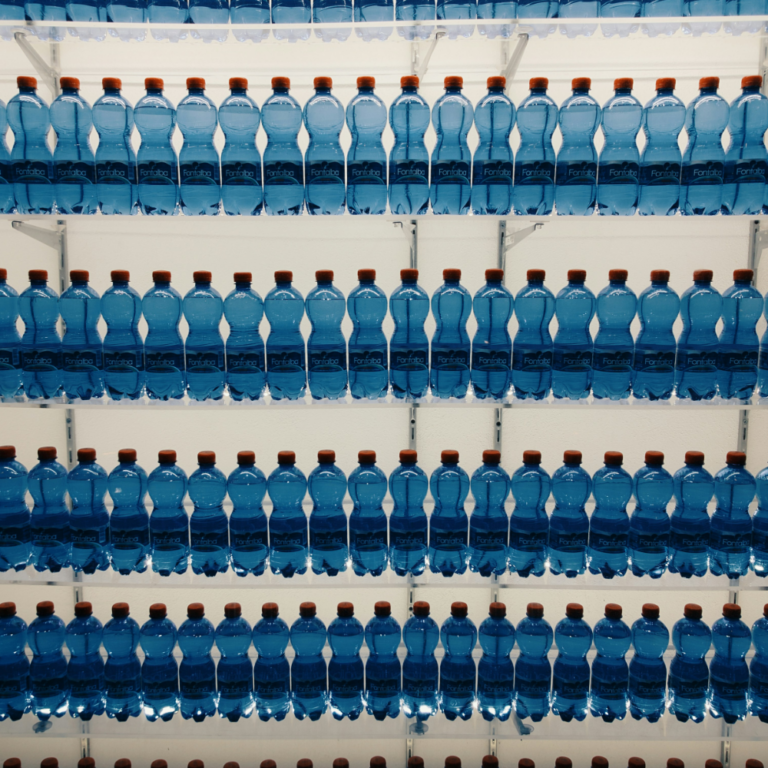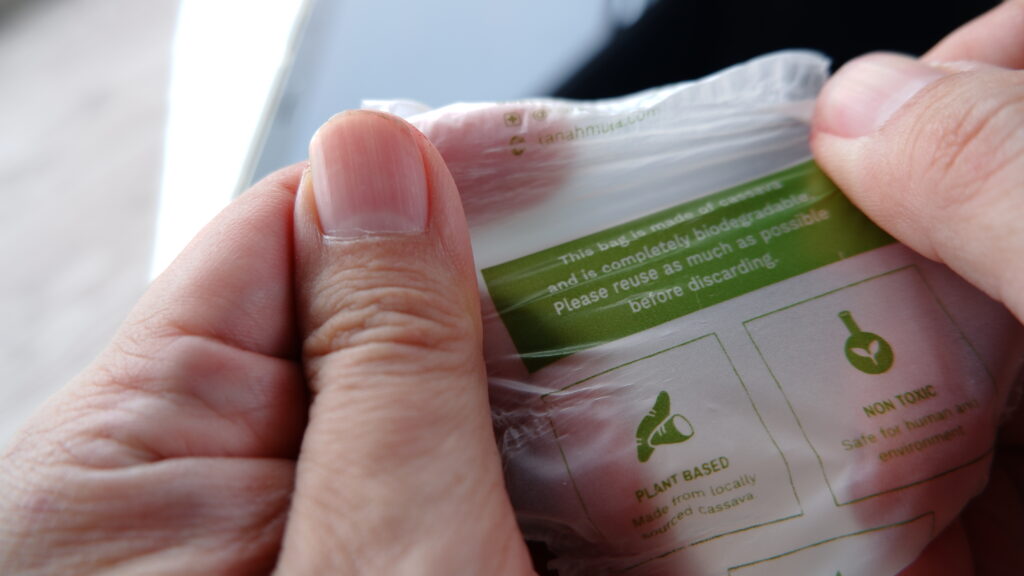
Key Takeaways
- Compostable products are certified to become safe compost; biodegradable only means it can break down over time.
- Dispose by the label and local rules: Home-labeled goes to backyard compost; Industrial-labeled goes to curbside compost only if accepted; otherwise trash—never recycling.
- Check trusted certifications like BPI, EN 13432, ASTM D6400/D6868, or TÜV OK Compost.
Did you know that 49% of consumers misunderstand the difference between biodegradable and compostable products? That mix-up often sends compostable packaging to the wrong bin, so it never delivers the environmental benefits it should.
Biodegradable means a material can break down over time. Compostable goes further: it’s designed to break down into safe compost within a set timeframe under the right conditions.
Mixing these up can contaminate recycling or compost bins, send good compostable items to landfill (where they may not break down well), and make “biodegradable” items seem greener than they are. Knowing the difference helps you choose better products and put them in the right place.
What Does Biodegradable Mean?
Biodegradable means a material can be broken down by naturally occurring microbes into simpler substances like water, CO₂ (or methane in low-oxygen places), and biomass; there’s no set timeline or guarantee it becomes entirely safe. Breakdown depends on heat, moisture, oxygen, and active microbes, so in landfills, it can take years and may only fragment.
Compostable items are a subset of biodegradable materials that are verified to break down under composting conditions into safe compost within a set time (e.g., ASTM D6400/EN 13432). Simply put, all compostable items are biodegradable, but not all biodegradable items are compostable.
How Biodegradation Actually Works
Biodegradation is nature’s recycling system. Microorganisms, such as bacteria and fungi, break down organic materials into simpler substances, including water, carbon dioxide, and biomass that enriches the soil. These microbes essentially consume the material as a food source, dismantling its molecular structure piece by piece.
The process isn’t automatic, though. These microorganisms require the optimal conditions to function effectively. With adequate temperature, moisture, and oxygen, they can break down a paper bag in just a few weeks. But in oxygen-poor environments like landfills, the same decomposition process can take years or even decades.
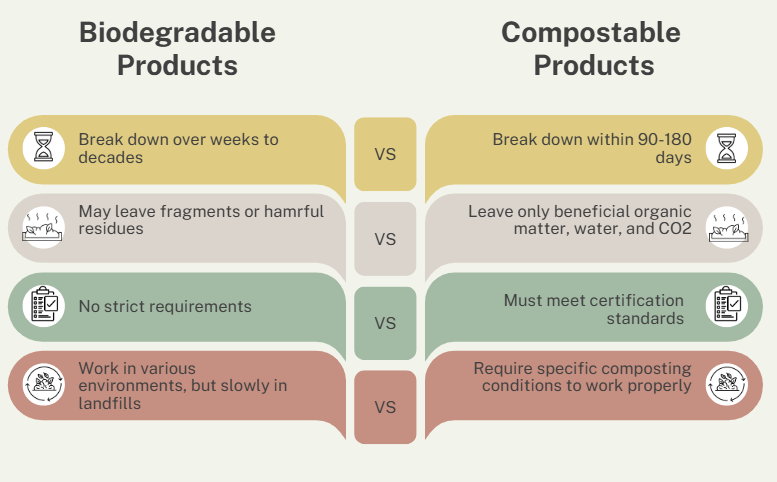
What Does “Compostable” Mean?
Compostable products are designed to break down quickly and safely in a composting environment, leaving behind nutrient-rich soil with no harmful residues.
Think of compostable items as the overachievers of the eco-friendly world. Unlike their biodegradable counterparts, these products must meet much stricter standards. They’re required to decompose within a specific timeframe, usually somewhere between 90 and 180 days, but only when they’re in proper composting conditions with the right temperature, moisture, and oxygen levels.
What makes compostable products special is what they leave behind, or rather, what they don’t leave behind. When they break down completely, you’re left with only water, carbon dioxide, and organic matter that enriches the soil, no toxins, no microplastics, no nasty surprises that could harm plants or animals later on.
The compostable label isn’t just a marketing claim either. These products must pass rigorous testing and earn certification from recognized standards, such as BPI, TÜV Austria, or EN 13432. These certifications ensure that when a company claims its product is compostable, it meets that promise under real-world composting conditions.
The Biodegradation Timeline: Why It Varies So Much
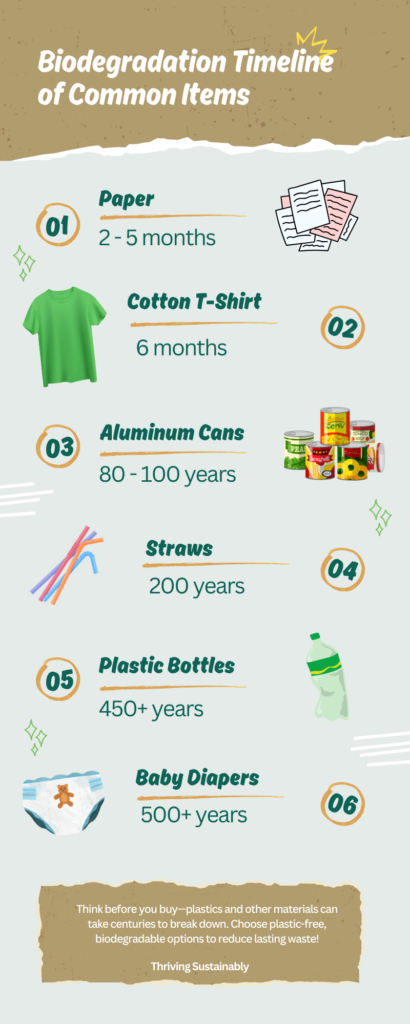
Not all biodegradable products decompose at the same rate. The timeline depends on both the material itself and the environment where it ends up.
A cotton t-shirt in a well-maintained compost pile might decompose within months, while the same shirt buried deep in a landfill could take years to break down completely. It’s all about access to the right conditions: oxygen, moisture, and active microbial communities.
Some “biodegradable” plastics can take decades to decompose, especially in landfill conditions where oxygen is limited and temperatures remain relatively stable.
Let’s clear it up!
Common Misconceptions About Biodegradable Products
There are several common misconceptions about biodegradable products that can result in improper disposal and unrealistic expectations. One frequent misconception is that these products will decompose quickly in any environment, but in reality, they often require specific conditions to break down properly.
“Biodegradable means environmentally harmless.”
Just because something is biodegradable doesn’t mean it’s automatically eco-friendly. Some biodegradable plastics can break down into tiny fragments, contributing to microplastic pollution, which can harm wildlife and enter food chains.
“It will decompose anywhere I put it.”
Many people believe that biodegradable items will break down no matter where they’re disposed of. However, most biodegradable materials require specific conditions—such as sufficient oxygen, moisture, and microbial activity—to decompose properly. These conditions are often lacking in landfills.
“Biodegradable and compostable mean the same thing.”
Although related, these terms have different definitions. Compostable materials must completely break down within a specified period under composting conditions, leaving no toxic residue. Biodegradable materials are only required to decompose eventually, a process that can take weeks, years, or even decades, depending on the environment.
The main distinction is that compostable materials are intended to become beneficial soil additives. In contrast, biodegradable materials are designed to break down over time, although not necessarily in an environmentally beneficial manner.
Biodegradable vs. Compostable: Which Option Is More Eco-Friendly?
Understanding these nuances can help you make more informed choices about the products you buy and how you dispose of them. While biodegradation is a natural process, it’s not an environmental cure-all. Knowing the details can help us aim for solutions supporting a healthier planet.
👣Carbon Footprint of Both Options
Biodegradable Items: Biodegradable items can release carbon dioxide (CO2) as they break down. In landfills, where oxygen is limited, they may also produce methane (CH4), a potent greenhouse gas with a much higher global warming potential than CO2.
Compostable Materials: Compostable materials break down in aerobic (oxygen-rich) conditions, such as composting environments. This process typically results in lower methane emissions compared to landfills, and composting can help sequester carbon in the soil, further reducing their overall carbon footprint.
🌱Soil Health and Ecosystem Effects
Biodegradable Items: Biodegradable materials may leave harmful chemicals or microplastics in the soil if they don’t break down fully. This can negatively affect plant growth and disrupt the ecosystem.
Compostable Materials: Compostable materials break down into organic matter that improves soil health, boosts nutrients, and supports a healthier ecosystem.
🎊Microplastic Concerns in Biodegradable Products
Biodegradable Items: Many biodegradable plastics still contain plastic-based polymers that fragment into microplastics. These tiny particles can persist in the environment, entering food chains and potentially harming wildlife.
Compostable Materials: Compostable products are designed to break down into non-toxic, organic components, reducing the risk of microplastic contamination in the soil and ecosystem.
⚖️Benefits and Drawbacks of Each Option
Biodegradable Items: While biodegradable materials may reduce waste compared to traditional plastics, they often break down slowly and incompletely, especially in landfills. They can contribute to microplastic pollution if not fully decomposed.
Compostable Materials: Compostable products generally break down quickly and improve soil health. However, they require the right conditions to compost properly. If disposed of improperly, they may fail to decompose, reducing their environmental benefits.
What to Look for on Labels
Skip the buzzwords. Look for test-backed marks that say how and where something should be composted.
✅Certifications to trust
These are third-party, standards-based labels. They confirm real compostability and indicate Home vs Industrial settings.
- BPI — Verified for industrial composting in North America; used only if your local program accepts it.
- TÜV OK Compost Home — Suitable for backyard composting.
- TÜV OK Compost Industrial — Requires a commercial facility.
- EN 13432 — EU standard for industrial compostability; widely recognized.
- ASTM D6400 / ASTM D6868 — U.S. specifications often used behind certifications; industrial composting.
🚩Red flags
These sound green, but they don’t provide verified end-of-life guidance. Treat them as not for compost (and never for recycling).
- “Biodegradable” with no certification — no timeline or proof that it becomes safe compost.
- Vague “eco-friendly/green” language — feel-good words, no disposal instructions.
- “Plant-based” only — source ≠ breakdown; may act like regular plastic unless certified compostable.
- Oxo-degradable — designed to fragment into microplastics; avoid.
Quick rule: If a label doesn’t clearly say Home or Industrial compostable and name the cert, don’t compost it.
tips
How to Dispose of These Products
- Biodegradable Items: Unless an item is certified for composting (and accepted by your local program), don’t send it to compost. Most “biodegradable” plastics aren’t allowed and won’t fully break down there. If it goes to a landfill, it can take years and may generate methane. When in doubt, trash it—not recycling.
- Compostable Items: If it’s TÜV OK Compost Home, backyard compost is fine (expect slower breakdown). If it’s BPI/EN 13432/ASTM D6400 (industrial), use your municipal compost bin only if your city accepts it. No access to industrial compost? Treat it as trash—never recycle.
- Tips for Reducing Waste: The key to managing biodegradable and compostable products is simple: try to use them less often. No matter how eco-friendly a disposable item is, it still becomes waste. Before choosing a compostable cup or a biodegradable bag, consider whether you truly need it or if a reusable alternative would be better. Often, the most sustainable option is the one that doesn’t need to be thrown away at all.
FAQs About Biodegradable vs. Compostable
Compostable means a product is proven to turn into safe compost within a set timeframe under composting conditions. Biodegradable only means it can break down over time and may not do so thoroughly, so it isn’t automatically compostable.
Look for a recognized certification on the package and whether it’s for Home or Industrial composting (BPI, TÜV OK Compost Home/Industrial, EN 13432, or ASTM D6400/D6868). Avoid vague green words without a certification.
Treat “industrially compostable” items as trash—don’t put them in compost or recycling. Use home-compostable items only if they’re clearly labeled and you maintain a backyard bin. Quick alternatives: paper or liner-free bins, reusables instead of “compostable” plastics, plain paper/cardboard disposables, or a local food-scrap drop-off if available.
Usually no. “Biodegradable” isn’t the same as compostable, and most programs don’t accept biodegradable bags in the green bin. Only use bags that are clearly certified for composting and accepted by your local program. Home compost piles rarely get hot enough for these bags to break down well. If your city doesn’t take them, treat them as trash. For food scraps, use paper liners or go liner-free; for regular trash, consider sturdy recycled-content bags.
Eco-friendly packaging and products come with a lot of buzzwords, and not all of them mean the same thing as “biodegradable” or “compostable.” Here’s how to read them:
Biobased — Made from plants or other renewable resources, like corn or sugarcane. This tells you where the material comes from, not how it breaks down. Some biobased plastics behave just like regular plastic unless they are certified compostable.
Organic — Grown or raised without synthetic chemicals or pesticides. While it’s suitable for farming practices, it doesn’t guarantee that the product will decompose quickly or safely.
Degradable — Means the product will eventually break into smaller pieces, but there’s no timeline or proof that it will entirely disappear. Regular plastic is technically degradable, and “Oxo-degradable” plastics often break into microplastics. This is different from biodegradable, which refers to microbial breakdown (though even that can be slow or incomplete).
Zero waste — A bigger lifestyle goal focused on reducing, reusing, and recycling to avoid sending trash to landfills. Compostable and biodegradable products can be part of it, but zero waste is about the whole system, not a single product label.
Final Thoughts on Biodegradable vs. Compostable
Biodegradable and compostable aren’t the same thing. Compostable items are designed to break down into safe compost under the right conditions, whereas “biodegradable” means they may decompose over time. When shopping, look for clear labels indicating Home or Industrial compostable products, and follow your local rules for disposal. If your city doesn’t accept them, it’s better to put them in the trash than to risk contaminating recycling. Small, informed choices like these make a real difference.
📚References
- ASTM International. (2021). ASTM D6400-21: Standard specification for labeling of plastics designed to be aerobically composted in municipal or industrial facilities. https://www.astm.org/d6400-21.html
- ASTM International. (2021). ASTM D6868-21: Standard specification for labeling of end items that incorporate plastics and polymers as coatings or binders designed to be aerobically composted in municipal or industrial facilities. https://www.astm.org/d6868-21.html
- Biodegradable Products Institute (BPI). (n.d.). Compostability certification. https://bpiworld.org/certification
- Closed Loop Partners (Composting Consortium). (2023, July). Unpacking labeling and design: U.S. consumer perception of compostable packaging. https://www.closedlooppartners.com/wp-content/uploads/2023/07/Composting-Consortium_Consumer-Insights-Report.pdf
- European Bioplastics e.V. (2015). EN 13432—Requirements for packaging recoverable through composting and biodegradation (Factsheet). https://docs.european-bioplastics.org/publications/bp/EUBP_BP_En_13432.pdf
- European Commission. (n.d.). EU restrictions on certain single-use plastics (including products made of oxo-degradable plastic). https://environment.ec.europa.eu/topics/plastics/single-use-plastics/eu-restrictions-certain-single-use-plastics_en
- TÜV AUSTRIA. (n.d.). OK compost Home—Certification overview. https://www.tuv-at.be/green-marks/ok-compost-home/
- TÜV AUSTRIA. (n.d.). OK compost Industrial—Certification overview. https://en-trustit.tuv.at/ok-compost-industrial-en/
- U.S. Environmental Protection Agency. (2024, November 21). Frequently asked questions about plastic recycling and composting. https://www.epa.gov/trash-free-waters/frequently-asked-questions-about-plastic-recycling-and-composting


